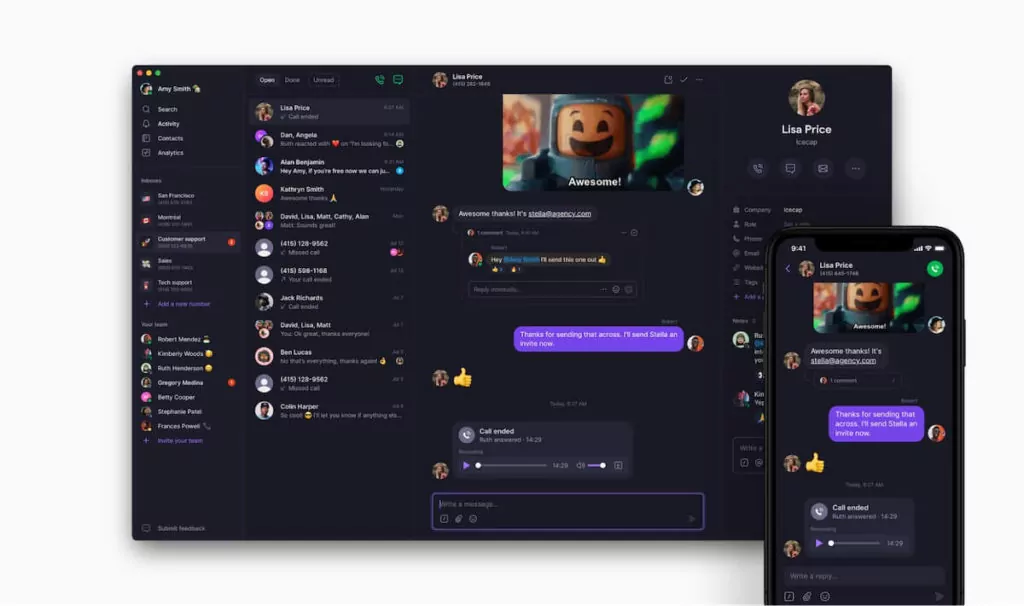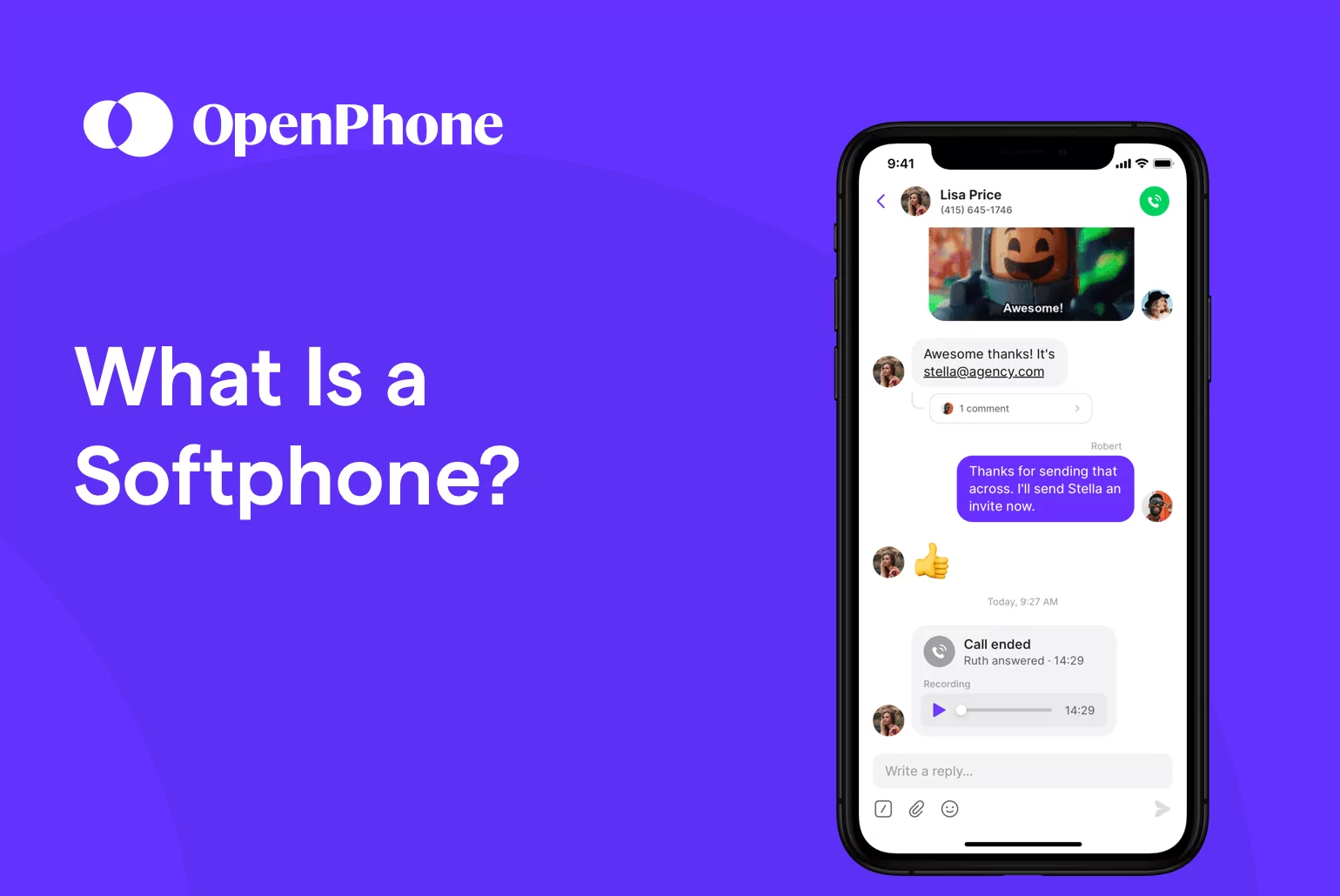With so many businesses going remote or a hybrid mix of office and remote work, many are turning to more flexible business phone solutions — that don’t require you to be at your desk or give out your personal cell number.
For teams and entrepreneurs, the ideal solution is modern, digital softphones. But what is a softphone? And how can they help your business thrive?
We’ll explain all you need to know about softphone systems, from what they are and how they work to why you should use a softphone for your business now.
What is a softphone?
A softphone is a type of software that allows you to send and receive texts and phone calls using an internet connection. All you need is an internet-enabled device, such as a cell phone or computer, to get the perks of a desk phone (and often much more). Thanks to softphones, physical phone lines and extra bulky hardware are no longer necessary to have a complete business phone system. ☎
When you choose softphone software instead of traditional desk phones, your team is no longer tied to an office. Softphone technology, sometimes known as Voice over Internet Protocol (VoIP) technology, unlocks the option for teams to go remote, hire from abroad, or stay in touch while on the go. It’s a perfect fit for businesses in modern times, in which 70% of workers are expected to work remotely five or more days per month by 2025.
How do softphones work?
Softphones are easy to set up and use, especially compared to traditional phones. With no physical setup required, getting started can take as little as a few minutes. Getting a VoIP phone number is often as simple as signing up for an account and downloading a softphone app on a compatible device.
Many softphone VoIP providers will even let you make and receive calls and texts from within your web browser. An internet connection is a must, but additional hardware like headsets are totally optional. 🎧
With softphones, your phone number is tied to a virtual account, rather than a specific landline, mobile device, or location. VoIP phone systems recognize you based on your login. If jumping on your computer isn’t convenient, you can log in via your mobile phone and still get access to all your telephone calls, text messages, and other features that your service provider offers.
Before you sign up for a VoIP phone service, make sure the provider’s software is compatible with your preferred devices to avoid any softphone issues. OpenPhone, for instance, works with iOS, Android, Mac, and Windows devices, as well as web browsers.
Common softphone features
Softphones offer robust functionality that covers far more than basic telephony needs. Features like voicemail, caller ID, call holding, and mute — which are common on cell phones and desk phones — come standard with most softphone apps, too. But if you’re looking for a little (or a lot) more, softphones won’t disappoint. VoIP providers like OpenPhone also include features like:
- Unlimited calling, SMS, and MMS in the US and Canada
- Shared phone numbers
- Voicemail transcriptions
- Call recording
- Call waiting
- Call transfers (including cold and warm transfer options)
- Integrations with email, Slack, Zapier, and HubSpot
- Analytics
- Auto-attendant (IVR)
Plus, since your phone number isn’t tied to a specific location, softphones allow you to choose from a variety of area codes (in the US and Canada, with OpenPhone). Whether you have multiple locations or want to build a local presence in a specific area, you can have as many phone numbers as you’d like on your account. OpenPhone also supports free phone number porting, if you want to keep an existing number, as well as toll-free phone numbers.
5 benefits of using softphones
Switching to softphones is a definite no-brainer. Not only do they make it simple to sign up for phone numbers, but softphones can also streamline your business communication far more than traditional phones. Here are five perks you can benefit from when you switch to a VoIP service.
1. Work wherever you go
Softphones allow you to work from anywhere, with practically any device. As long as you have a reliable internet connection, you can start managing your calls and texts in real time from a browser, desktop, or mobile app. It’s safe to say we’ve come a long way from the days of corded telephones and landlines. With softphones, hardware will never hold you back. You can get access to new features just by updating your app.
Since your team is no longer tied to a single office space, you can easily build a remote team or hire talent from anywhere in the world. With OpenPhone, for instance, all it takes is an email invite and a brief onboarding process for team members to access their softphone. Even if they’re working from an entirely different continent, your employees can start managing a brand-new number that’s unique to them, or a shared phone number, which allows you to build a virtual call center.
2. Easy to scale
Ready to grow your business? Softphone systems are prepared for growth, too. When you hire someone new, you can add them to your system within minutes for a small extra monthly fee.
Compare this with scaling a business on desk phones. Each time you hire, you’ll need to manage a physical setup process and purchase brand-new hardware. And if you want new phone features, you’ll need to purchase and set up new hardware for your entire team. It’s not convenient, time-efficient, or cheap — whereas setting up a softphone is all three.
3. No IT tickets needed
Softphone apps are user-friendly platforms that most smartphone users (or the majority of US adults) can learn to use within minutes — even without any training. They’re designed like the built-in phone apps that you’re used to. Everything from your digital dialpad to your text messaging interface will feel familiar.
With softphones, you won’t have to worry about calling up an IT pro to learn how to do something as simple as setting up a voicemail greeting. But if you ever do get stuck, many softphone providers offer free customer support, so you can reach out to experts and keep your business running smoothly.
4. Balance life without the bulk
With a softphone, it’s simple to get a second, business-dedicated number on your existing cell phone. No need to carry around two devices. When you sign up for a VoIP phone number, you can start making and receiving business calls from the softphone app, while still keeping your personal calls separate. Softphones are a smarter way to achieve work-life balance — and they’ll free up a pocket.
5. Lower costs
If you want major cost savings (what business doesn’t?), softphones may be the perfect fit for your team. Since your phone will run on the internet, you don’t have to invest in any extra hardware. Team members can manage their calls from their computer or from their personal smartphones (without ever revealing their personal phone number to customers or mixing their personal contacts in with their business contacts). With OpenPhone, plans start at $15 per user per month.
Another financial perk of switching to softphones is often lower long-distance prices. If you have a global client base, softphones like OpenPhone can help you save money on international calls and texts with lower rates than landlines. You can also call and text US and Canadian clients for free by claiming a local number — even if you live abroad.
Get started with softphones

With the rise of softphones, desk phones and work-only cell phones are quickly becoming outdated business tools. When managing calls and texts is as easy as logging into an app, there’s no reason you should keep your phone number tied to a single location or device. Softphones provide greater mobility, scalability, and ease of use for far better prices.
OpenPhone is a softphone that offers far more features than you’d expect from a traditional phone, too. With business app integrations, call forwarding, analytics, and more, OpenPhone can help you get smarter about your client communications. Start your free trial of OpenPhone to get the business phone features you really need to thrive.
Yes, many softphone service providers, including OpenPhone, allow you to port your existing phone number to their system, ensuring you can maintain your established contact with clients and partners without interruption.
When choosing a softphone number for your business, consider your client base location and whether a local or toll-free number could best serve their needs and enhance your business presence.
A softphone system operates over the internet, while a traditional phone system uses physical hardware. Softphones offer greater mobility, scalability, and ease of use for lower costs compared to traditional phones.
Yes, most softphone platforms, including OpenPhone, support the use of your softphone client account on multiple devices at once. This means you can manage calls and texts seamlessly across your smartphone, tablet, and desktop, ensuring you stay connected and responsive to your client base from anywhere.
